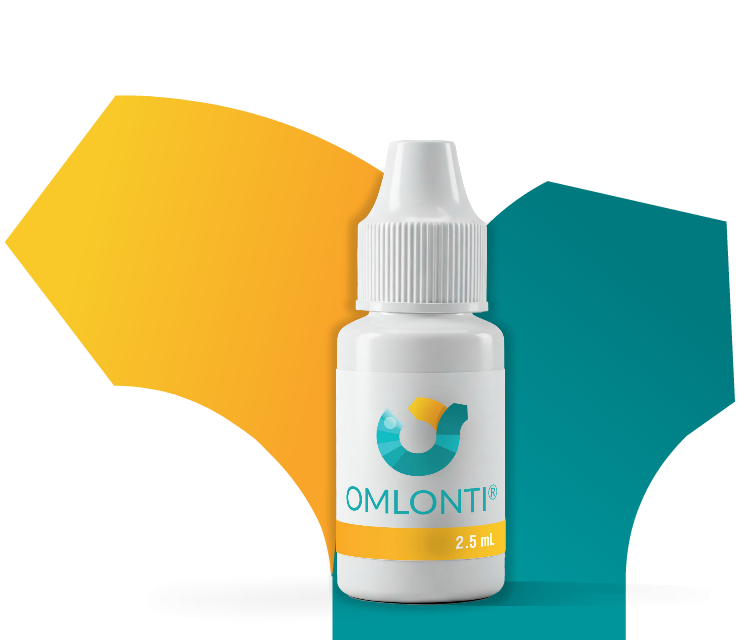a first-in-class EP2 receptor Agonist for the treatment of open-angle glaucoma and ocular hypertension
Dual Action
OMLONTI® is a selective EP2 receptor agonist that reduces intraocular pressure by increasing both uveoscleral and trabecular outflow while preserving the integrity of periorbital tissue.

REcently Diagnosed?
Learn more about eye pressure and how it can affect your sight.
Looking for a better option?
Learn more about how OMLONTI can provide extra benefits in a once daily drop.
Looking for resources?
There is support if you have been diagnosed with open angle glaucoma or ocular hypertension.
Frequently Asked Questions
General info about Omlonti
Omlonti is a first in class EP2 agonist once a day eye drop used to treat high eye pressure/intraocular pressure (IOP) in people with open-angle glaucoma or ocular hypertension.
OMLONTI (omidenepag isopropyl) can help control eye pressure in people with open-angle glaucoma or ocular hypertension and may help reduce the risk of visual field loss.
OMLONTI works to reduce eye pressure through a specific and highly targeted mechanism:
EP2 Receptor Agonism:
It is a relatively selective prostaglandin EP2 receptor agonist. This means it activates the EP2 receptors in the eye.
By activating these receptors, it increases the outflow of aqueous humor, the fluid inside the eye.
Increased Aqueous Humor Outflow:
This increased outflow occurs through both the trabecular and uveoscleral pathways, which are the main drainage systems of the eye.
The EP 2 receptor is very well expressed in eye tissues and provides a novel, highly selective way to target eye pressure reduction. Compared to some existing glaucoma medications, an EP2 agonist like OMLONTI may offer a different or complementary mechanism of action. This could be beneficial for patients who don’t respond well to current treatments or who experience side effects. Also some EP2 agonists, may have a lower propensity to induce some of the side effects that are associated with Prostaglandin F (FP) receptor agonists.
EP2 agonism can increase aqueous humor outflow through both the:
Trabecular meshwork (conventional outflow pathway): This is the primary drainage system of the eye.
Uveoscleral outflow pathway: This is an alternative drainage route
Keep OMLONTI® and all medicines out of the reach of children.
Store unopened OMLONTI® in the refrigerator between 36°F to 46°F (2°C to 8°C).
After opening, store OMLONTI® up to 31 days at room temperature between 68°F to 86°F (20° to 30°C).
Do not use OMLONTI® if the expiration date (EXP YYYY-MM) on the outer carton and multi-dose bottle have passed. The expiration date is the last day of that month.
After removing the tamper-evident overcap, keep the multi-dose bottle closed with the inner screw cap on to avoid contamination.
About the Early experience program
With the OMLONTI® Early Experience Program, you can provide a free trial of this novel treatment to adults under your care who have been diagnosed with open-angle glaucoma or ocular hypertension.
Each sample box contains 12 individual kits for 12 patients. Each kit includes a free 3-month supply of OMLONTI®, as well as a patient education leaflet, full Prescribing Information, and Instructions for Use. Samples should be refrigerated until distribution to patients.
Patients who may benefit from starting or switching to OMLONTI® include those who are:
Those who are poorly responding to prostaglandins
Ocuvex is excited to provide you with free samples of our treatment OMLONTI® to help lower your patients’ intraocular pressure.
Simply click on the button below and follow the simple steps when prompted:
How To Use Omlonti?
The recommended dose for OMLONTI is one drop in the affected eye(s) once daily in the evening.
If you miss a dose of OMLONTI, you should continue with your next dose the following evening.
Yes
If you wear contact lenses, remove your contact lenses before using OMLONTI. You should wait 15 minutes after using OMLONTI before placing your contact lenses back in your eye
If more than 1 eye drop is being used, the drugs should be administered at least 5 minutes apart
About Glaucoma and High Eye Pressure
No
You can’t usually feel high eye pressure. Often there are no symptoms at first, however the pressure might be damaging your sight. As a result it is important to have regular eye exams
High eye pressure (intraocular pressure or IOP) is a significant risk factor for glaucoma. When the pressure inside the eye is too high, it can damage the optic nerve, which can lead to vision loss. However, it’s important to note that not everyone with high eye pressure develops glaucoma, and some people develop glaucoma with normal eye pressure.
Glaucoma is diagnosed through a comprehensive eye exam that includes:
- Examining the drainage angle of the eye (gonioscopy).
- Measuring intraocular pressure (tonometry).
- Examining the optic nerve
- Testing the visual field.

